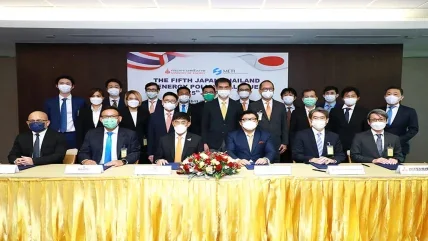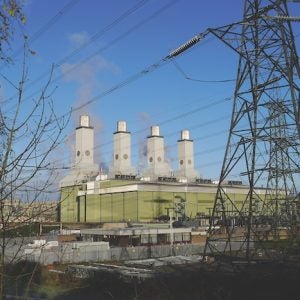
Mitsubishi Heavy Industries has, for example, recently signed a memorandum of understanding (MoU) to collaborate on a feasibility study of ammonia co-firing at a coal-fired power plant in Thailand.
The plant in question is owned and operated by BLCP Power Limited (a Thai IPP, which is a 50:50 joint-venture of Banpu Power Public Company Limited (BPP) and Electricity Generating Public Company Limited (EGCO Group)).
The project, which also involves JERA, as well as BPP, EGCO and Mitsubishi, aims to decarbonise the existing power plant, “supporting Thailand in achieving its climate ambitions and becoming a low-carbon society.”
Under the feasibility study plan, MHI, with support from Mitsubishi Power, will investigate the supply of ammonia burners, boiler facilities and equipment necessary for ammonia co-firing. JERA will examine the procurement and transportation of ammonia fuel, while JERA and Mitsubishi Corporation will assess port facilities and capabilities for ammonia receiving and storage, with the aim of establishing “an integrated fuel value chain from procurement to utilisation.” BLCP, MHI, Mitsubishi Corporation and JERA will also “jointly conduct studies and develop plans to achieve up to 20% ammonia co-firing.”
Located in Rayong province in southeastern Thailand, the BLCP power station comprises two subcritical coal-fired boilers with a total output of 1434 MW that entered operation in 2006 and 2007. MHI supplied the boilers, steam turbines, and other main equipment for the power station.
Thailand has announced its commitment to reach carbon neutrality by 2050, and net zero greenhouse gas emissions by 2065 and says it plans to strengthen co-operation with Japan on decarbonisation and use of ammonia and hydrogen.
In December 2022, MHI signed an MoU with Guacolda Energia SpA, a Chilean IPP, with the aim of carrying out a feasibility study on introducing ammonia co-firing at a Guacolda-operated coal-fired power plant in the north of the country, again a facility where MHI supplied the boiler, steam turbine, and other key components.
The signing ceremony was held at the Nagasaki Shipyard & Machinery Works in Japan, the base for MHI’s steam power plant business. The executive team from Guacolda was led by chairman Jorge Rodriguez, with MHI represented by Masahiko Hokano, head of the Steam Power Maintenance Innovation (SPMI) business division.
The power plant that is the subject of the study is located in Huasco, Atacama region, about 700 km north of Santiago. The plant comprises five units, with a total output of 758 MW.
The Mitsubishi scope in Chile will be similar to that envisaged for the BLCP project in Thailand, including feasibility of ammonia burner supply and other boiler systems necessary for ammonia co-firing. Phase 1, running until 2024, will be a basic study of 30% ammonia co-firing to identify the problems involved. Phase 2, from 2025 to 2026, will consider solutions to problems identified in Phase 1, and result in a detailed plan for demonstration of 30% ammonia co-firing. Looking beyond that, Guacolda aims to conduct demonstration testing at the plant and increase the co-firing rate.
Chile has set a target for carbon neutrality by 2050 and plans to increasingly incorporate renewables into its electricity matrix. As a country with abundant renewable energy resources, Chile is considered to have big potential as a producer of green ammonia, and Guacolda is looking to ammonia co-firing as a means of cutting CO2 emissions and reducing its environmental load ”in order to maintain operations at its power plant.”
MHI says its position “as the supplier of the core facilities of this power plant, and a leader in ammonia co-firing technologies, led to the conclusion of this MoU.”
MHI is also working with state-owned Taiwan Power Company (TPC) on a study of how ammonia co-firing might be introduced at the Linkou coal-fired power plant, New Taipei, with the aim of reducing coal consumption.
The Linkou power plant, located some 20 km west of central Taipei, comprises three supercritical coal-fired boilers and steam turbines supplied by MHI, with total installed capacity of 2400 MW.
The first phase of the Linkou ammonia project, running until the end of 2025, will consist of a basic study aimed at 5% ammonia co-firing, with MHI looking at the supply of ammonia burners and related equipment and Mitsubishi Corporation focused on how to build a supply chain “to secure a stable supply of clean fuel ammonia.”
The second phase of the project, from 2026 onwards, will see “use of one of the units at the Linkou power plant for verification, with the aim of 5% ammonia co-firing in 2028 to 2030, raising the co-firing ratio to 20% and implementing the system for the plant’s other units.”
MHI notes that Taiwan is facing the challenge of ensuring a stable power supply against a backdrop of robust demand, while also under intense pressure to reduce environmental loads and achieve decarbonisation of its gas and coal fired generating capacity. In March 2022, Taiwan published its Pathway to net-zero emissions in 2050, with co-firing of coal and ammonia a decarbonisation technology expected to be capable of having a significant impact, says MHI, which has been a major supplier of fossil fired power generation plants to TPC.
Indonesia is another place where Mitsubishi has been a key provider of fossil-fired power generation technology over the years and is now working on ways to decarbonise the existing fleet by switching to lower carbon fuels.
Under an MoU agreed between MHI and PLN Indonesia Power, a subsidiary of Indonesia’s state-owned electricity provider PT, three feasibility studies are being carried out on co-firing less carbon intensive fuels at power plants owned and operated by Indonesia Power. The three studies are being conducted jointly by Indonesia Power and MHI/Mitsubishi Power.
The first study is examining the technical and economic feasibility of co-firing up to 100% biomass at the Suralaya coal-fired power plant (CFPP). The study will consider various aspects of the biomass supply chain, says Mitsubishi, including handling, storage, transport and boiler modification.
The second study, which will also use Suralaya CFPP as the reference plant, will investigate co-firing of ammonia produced by existing ammonia plants in Indonesia. A particular area of focus will be the potential to establish a blue ammonia supply chain, with production and transportation from the ammonia plant and ammonia co-firing technology applied in an existing boiler.
The third study is evaluating the technical and economic feasibility of hydrogen co-firing in an MHI-supplied M701F gas turbine at the Tanjung Priok combined cycle facility.
Power company collaborations
Meanwhile, on the utility side, JERA (Tepco/Chubu Electric 50:50 joint venture that provides about 30% of Japan’s electricity), is also proving very active in exploring possibilities for using ammonia as a fuel in existing fossil-fuelled power plants.
It has, for example, signed an MoU with Aboitiz Power Corporation (a subsidiary of the conglomerate , Aboitiz Equity Ventures) to undertake a joint study of ammonia co-firing at coal fired power plants in the Philippines. (JERA is an investor in Aboitiz through JERA Asia Pte. Ltd.)
JERA also has memoranda of understanding in place with leading ammonia suppliers Yara and CF Industries under which they are looking at collaboration possibilities in the following areas:
- Sale and purchase of clean ammonia for the planned 20% ammonia co-firing at unit 4 of JERA’s Hekinan coal-fired power plant in Japan, which is targeted to start in 2027. The volume of ammonia required is expected to be up to 500 000 mtpa.
- The joint development of 1 million plus mtpa blue ammonia projects that Yara and CF are considering, to be located on the US Gulf Coast.
CF Industries, based in Illinois, USA, is the world’s largest producer of ammonia, and is said to be actively working to decarbonise the ammonia production process. Yara, based in Norway, is one of the world’s largest producers of ammonia and is also working towards decarbonisation.
JERA notes that the execution of these MoUs is the result of a tender process for the procurement of clean ammonia that it started in February 2022.
Through this process, JERA says it has entered into discussions with various companies “to compare and evaluate them to determine the potential partners with which it will co-operate in sourcing the clean ammonia for the world’s first commercial scale ammonia co-firing operations.”
JERA is also collaborating with IHI to explore potential ways to expand the use of ammonia in Malaysia’s energy sector, including ammonia co-firing at fossil fired power plants. IHI is estimated to have delivered more than 50% of the installed coal-fired power boiler capacity currently in operation in the country.
Malaysia’s 12th Malaysia Plan says it will reduce GHG emissions by 45% by 2030 (from 2005 levels) and achieve carbon neutrality by 2050, with both ammonia and hydrogen expected to play a role in achieving this goal.
Among projects that JERA and IHI are already working together on is the introduction of 20% ammonia co-firing at the Hekinan coal-fired plant (supported by a grant from NEDO (New Energy and Industrial Technology Development Organization)), with demonstration of a co-firing ratio of over 50% envisaged in the future.
JERA has in addition a memorandum of understanding in place with utility peers, Kyushu Electric, Chugoku Electric, Shikoku Electric, and Tohoku Electric, with the aim of exploring collaboration “aimed at the adoption of hydrogen and ammonia as fuel for power generation.”
These Japanese power plant owner/ operators “have all been studying ways to use hydrogen and ammonia in their thermal power plants”, says JERA, and “securing large volumes of hydrogen and ammonia to fuel power generation requires establishing and expanding new supply chains through co-operation among companies that are motivated to realise a decarbonised society.”
The MOU, signed in April 2022 by JERA, Kyushu and Chugoku, and recently signed by Shikoku and Tohoku, stipulates that the five companies, each of which operates large-scale fossil-fuelled power plants in Japan, will discuss possibilities for collaboration in the following areas aimed at establishing and expanding supply chains for hydrogen and ammonia for fuel:
- joint procurement aimed at reducing hydrogen and ammonia procurement costs for Japanese domestic power plants;
- establishment of transportation and storage systems for hydrogen and ammonia; achievement of policy support and development of a regulatory framework for hydrogen and ammonia; and
- consideration of collaborative projects related to the introduction of hydrogen and ammonia in Japan.
Collaboration by the five companies — all major Japanese electric power companies with large-scale potential demand for hydrogen and ammonia — will “contribute to the early establishment of a stable and economic supply chain” for next-generation, low carbon fuels, says JERA.






